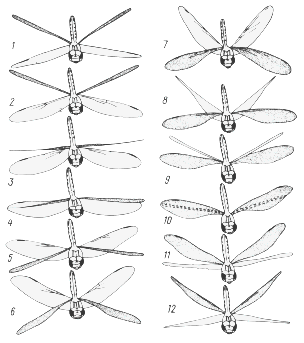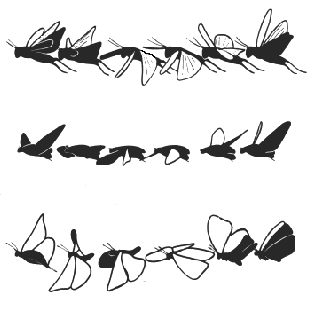 How Insects Fly
How Insects Fly
Flapping Flight
The ancient order Odonata, one of the oldest extant insect
groups and comprising the dragonflies and damselflies, flaps both pairs of
wings separately, the two pairs beating in opposite phase. The Megasecoptera, early members of this
order, probably tended to fly along a straight path with only gentle turns. Ancient dragonflies had
wings spans ranging up to about one metre (the largest of all time) and were gliders. Modern dragonflies
and damselflies, however, are capable of flying in any direction without turning their bodies.
They are aerial predators and, despite the primitive arrangement of their wings, they are excellent
fliers. It is this arrangement of the wings which causes the clacking sound which is often heard
in marshes. When a dragonfly turns, its fore and aft wings hit each other, producing a characteristic
clacking.
Below is a diagram illustrating one full wing-beat of the dragonfly Aeschna juncea. The upper
surface of each wing is shaded.

Shown below are the flapping motions of a single wing beat of three types of
insect: locust, butterfly, and beetle. The locust (top row) beats its four wings out
of phase, but not as dramatically so as the dragonfly (above). The butterfly
bottom row) flaps its wings in phase, because it holds them together in one aerodynamic
surface. The beetle (middle row) only beats two wings, the forward pair being
shields and held out of the way of the rear pair.

Beetles, in fact, prefer running to flying when they have a choice. Beetles generally are not good fliers,
as the aerodynamics are spoiled by the shells which they must hold wide open, as a June beetle does
as it flies around the patio lamp in summer. Several beetle species cannot fly at all, but rely
on their armor and their legs to protect them.

 How Insects Fly...3, March 1996
How Insects Fly...3, March 1996

 How Insects Fly
How Insects Fly


 How Insects Fly...3, March 1996
How Insects Fly...3, March 1996